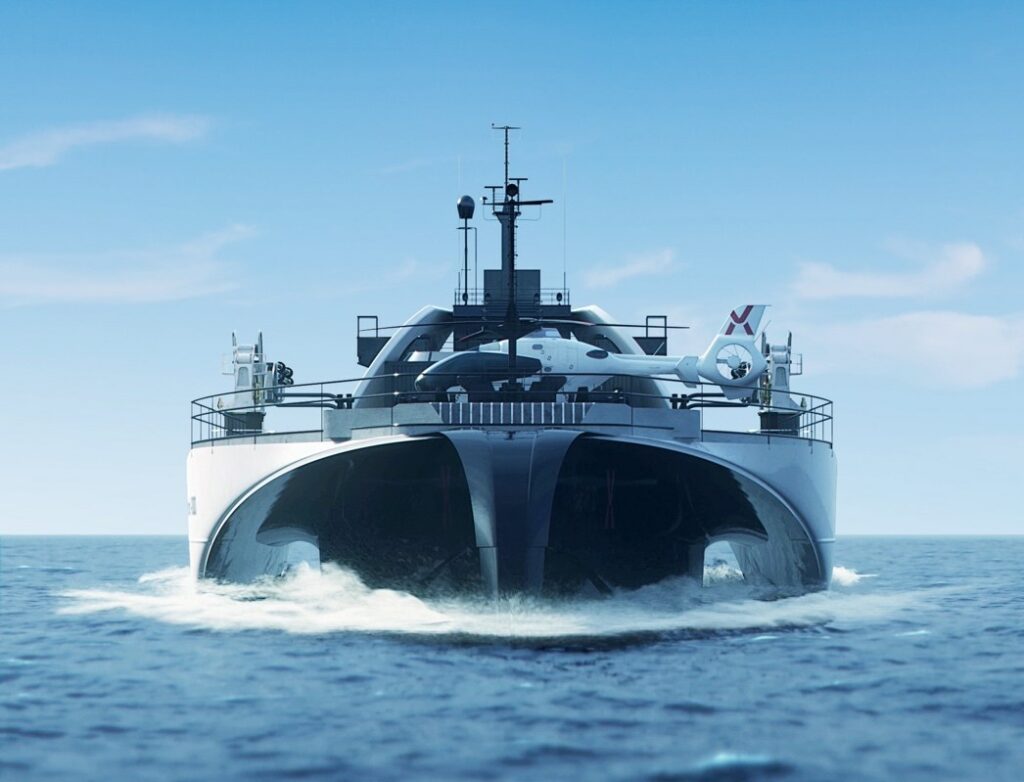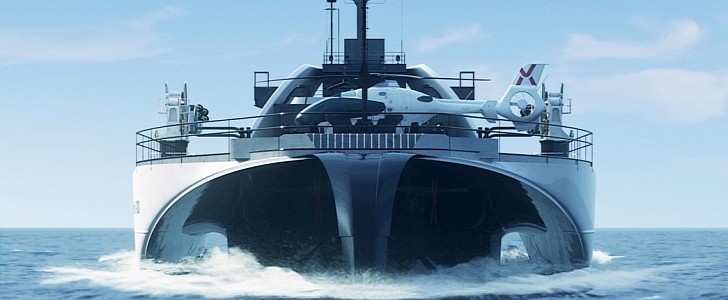Japanese Ship of the Future for Clean Energy Transport Can Carry 100 Grid Batteries
Three experts, with backgrounds that complement each other, decided to join forces and found PowerX, a company that aims to develop “the energy ship of the future”. Paolo Cerruti, founder of the first European Giga-scale battery maker, Caesar Sengupta, from Google, and Mark Tercek, the former CEO of The Nature Conservancy, have an ambitious vision for Japan and a green future.
Power ARK 100 will be the first model of the Power ARK series, a trimaran that will transport renewable energy around Japan. According to the company, using a ship instead of undersea power cables, to transport offshore wind power to shore, will be more cost-effective, will require less time and will eliminate the potential damage caused by natural disasters.
The Power ARK 100 is set to have a huge battery payload, being able to carry up to 100 grid batteries, which add up to 200 MWh of power. Apparently, it’s designed as a hybrid vessel that boasts a 186-mile (300 km) range when running exclusively on electricity, and long-distance travel capabilities, when powered by biodiesel fuel as well.
And that’s not all. PowerX is also building Giga-scale battery plant in Japan, with automated production lines, which will manufacture grid batteries, marine batteries and even ones for EV fast-charging. The plan is for this facility to achieve an impressive 5GWh annual production capacity, by 2028.
Until then, the Power ARK 100 “energy vessel” is set to begin carrying clean energy by 2025.
Japanese firm looks to build next generation of energy transfer ships

Japanese company PowerX has unveiled plans to design and build an automated power transfer vessel to carry electricity from offshore wind farms to shore by 2025. The aim is to enable energy transmission between any two ports on the planet.
PowerX said it will develop a vessel with a massive battery payload that is integrated with the ship’s controls that is resilient to natural disasters, requires less time and cost for development and leaves minimal impact on the environment compared to subsea power cables.
“As the world shifts away from fossil fuels, the energy ship of the future will carry electricity from clean and renewable sources, replacing the fuel-carrying carbon ships of today,” the company said.
The very first model of the so-called Power ARK series, “Power ARK 100”, is a 100 teu trimaran specially designed for transferring renewable energy in Japan’s coastal waters. When completed, the ship will carry 100 grid batteries, or 200 MWh of power, equivalent to the total electricity consumption of 22,000 Japanese households in a day.
The vessel can travel up to 300 km when running only on electricity and will be able to unlock long-distance, intercontinental clean power transmission when it is powered by both electricity and sustainable biodiesel fuel.
To realise its vision, PowerX will also be building a giga-scale battery assembly facility in Japan to mass-produce batteries for the next generation of energy transfer ships. The factory’s annual production capacity will reach 1 GWh by 2024, and will eventually reach 5 GWh by 2028.
Currently, Paolo Cerruti, co-founder and COO of Northvolt, Caesar Sengupta, ex-VP and general manager at Google, and Mark Tercek, former CEO of The Nature Conservancy and former partner at Goldman Sachs, are the non-executive directors of PowerX.
Transporting Offshore Wind Electricity by
August 19, 2021, by Adnan Durakovic
Japanese company PowerX plans to design and build an automated Power Transfer Vessel to carry electricity from offshore wind farms to shore.

The Power ARK 100 is a 100 TEU trimaran specially designed for transferring renewable energy in Japan’s coastal waters.
Upon its completion in 2025, Power ARK 100 will carry 100 grid batteries, equating to 200 MWh of power which is equivalent to the total electricity consumption of 22,000 Japanese households in a day, PowerX said.
The vessel will be able to travel up to 300 kilometres when running only on electricity and will be able to unlock long-distance, intercontinental clean power transmission when it is powered by both electricity and sustainable biodiesel fuels, the company said.
PowerX will also build a gigawatt-scale battery assembly facility in Japan to mass-produce batteries for the Power Transfer Vessels. The factory’s annual production capacity will achieve 1GWh by 2024, and will eventually reach 5GWh by 2028, PowerX said.
The Japanese government plans to develop 10 GW of offshore wind capacity by fiscal 2030 and 30-45 GW by fiscal 2040.
According to PowerX, Japan is surrounded by deep coastal waters which limit the potential range for setting up offshore wind farms. PowerX intends to change how the world consumes and transfers renewable energy by providing a unique solution that can lift the restriction on power generation location, which will allow a greater flexibility for offshore wind farm locations, especially for an island country like Japan, the company said.

No comments:
Post a Comment